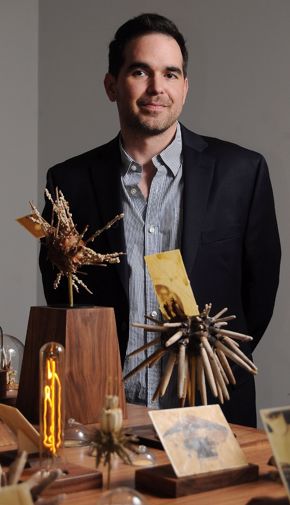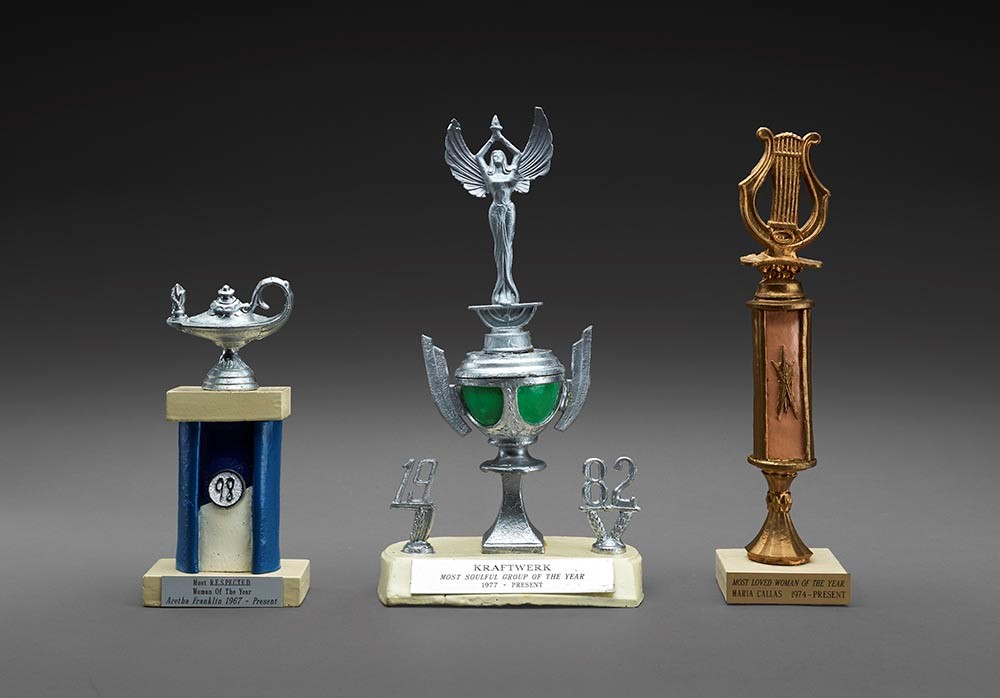3 Questions for Artist Dario Robleto August 12, 2019

Dario Robleto
Photograph courtesy of the artist and Inman Gallery © David Rossman
Dario Robleto, I Wish I Could Give Aretha All the R.E.S.P.E.C.T. She Will Ever Need; I Wish I Could Give Kraftwerk All the Soul They Will Ever Need; I Wish I Could Give Maria All the Love She Will Ever Need / 1998–99 / .A: found and thrift-store trophy parts with melted Aretha Franklin 45 rpm records (“You Make Me Feel Like a Natural Woman,” “Prove It,” “Chain of Fools”), resin, spray paint, engraved silver label / .B: found and thrift-store trophy parts with melted Kraftwerk records (“Computer World,” “The Man Machine,” “Trans-Europe Express”), resin, spray paint, engraved chrome label / .C: found and thrift-store trophy parts with melted Maria Callas records (“Norma,” ”Madame Butterfly,” “Tosca”), resin, spray paint, engraved brass label, the Museum of Fine Arts, Houston, selected by Jereann and Holland Chaney, Museum purchase funded by Leslie and Brad Bucher in memory of Robert Chaney. © Dario Robleto
Houston-based artist Dario Robleto has won national recognition for his thoughtful investigation of the ways in which music forms an essential connection between art and life. Among his upcoming projects are several books and exhibitions, as well as two university residencies: one at Northwestern’s McCormick School of Engineering, the other at Harvard.
Many artists and writers before you have discovered ties between art and music: Goethe wrote about the “frozen music” of architecture, and Kandinsky stressed the symphonic nature of his first radical abstractions. You place emphasis on the importance of recorded music in your work, in some instances making sculptures out of vinyl records or magnetic tapes. How did this come about?
Those are great examples of artists feeling a deep connection between the visual, material, and audible. However, I have searched for something different in these connections; instead of using music as a metaphorical connection to the material, I wanted the very music itself to become the sculptural material, which using vinyl records allowed for. I root this interest in the audible and material back to a childhood experience most of us have had—listening inside a seashell. As silly or clichéd as that may sound, I never let go of the elemental magic: How is the incomprehensible vastness, the physical and emotional awe of the ocean “contained” through its sound in such a small vessel?
The Museum is fortunate to own three of your early trophy sculptures. You are very specific about the materials you used to make these. Can you describe your studio process?
I am particular in the materials I use because I am counting on the meaning embedded in a material in one state (a vinyl record, a love letter, a fossil, etc.) to be entirely transported into a new physical state (the sculpture). The disjointedness a viewer often feels between holding the idea of what the original material was (in these examples, vinyl records that were melted) and what it has now turned into (a series of trophies) is an exciting moment of wonder and of new possibilities crucial to my philosophies of art.
Discussing how a DJ puts together a playlist, you said, “A sampler is not just to make music with but a way to understand the world, a way to creatively filter and reconfigure it.” How does this apply to your work?
When I first discovered DJ culture and its core technique of sampling, I knew I had found a worldview, a philosophy of life. With deejaying and sampling, there is a subversive element that nothing is ever trash or the final say on a matter but rather calls that attitude out as a failure of the creative imagination. Although sampling is rooted in a technical skill of the manipulation of fragments of sound or music, as a way to move through life it can also increase one’s sensitivity of observation, challenge assumed limits of empathetic behavior, and build a relationship to history that is more depth than surface.
• Tribute Trophies
Dario Robleto’s trophies, made from melted vinyl records, pay tribute to some of his musical heroes: Aretha Franklin, Kraftwerk, and Maria Callas.
Left to right:
I Wish I Could Give Aretha All the R.E.S.P.E.C.T. She Will Ever Need
I Wish I Could Give Kraftwerk All the Soul They Will Ever Need
I Wish I Could Give Maria All the Love She Will Ever Need
LEARN MORE
• See details about the trophies here.
• Dario Robleto’s work was also featured in the exhibition Fear and Wonder: Sublime Landscapes on Paper—Selections from the Museum’s Collection.






